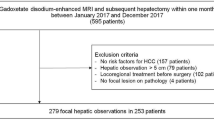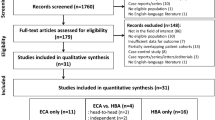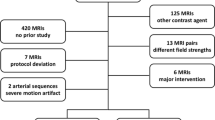Abstract
Objectives
The multiple arterial-phase (AP) technique was introduced for liver MRI, but it is not really known if multiple AP MRI (MA-MRI) improves image quality and lesion detection rate on gadoxetate disodium–enhanced MRI in comparison with single AP MRI (SA-MRI). We aimed to determine the clinical usefulness of MA-MRI in comparison with SA-MRI.
Methods
Original articles reporting the percentage of adequate AP imaging and the lesion detection rate on gadoxetate disodium–enhanced MA-MRI were identified in PubMed, EMBASE, and Cochrane Library databases. The pooled percentage of adequate AP imaging and lesion detection rate were calculated using random-effects meta-analysis of single proportions. Subgroup analysis was performed to explain causes of study heterogeneity, and publication bias was evaluated using Egger’s test.
Results
Of 772 articles screened, 22 studies in 12 articles were included: 18 studies (ten MA-MRI and eight SA-MRI) suitably defined the percentage of adequate AP imaging and four (three MA-MRI and one SA-MRI) defined the lesion detection rate. MA-MRI had 16.1% higher pooled percentage of adequate AP imaging than SA-MRI (94.8% vs. 78.7%, p < 0.01). MA-MRI additionally detected 33.2% of lesions than SA-MRI (83.2% vs. 50.0%, p = 0.06). Substantial study heterogeneity was found in MA-MRI, and the definition of adequate AP imaging, lesion characteristics, and reference standards were significant factors affecting study heterogeneity (p ≤ 0.02). Significant publication bias was found in MA-MRI (p < 0.01) but not in SA-MRI studies (p = 0.87).
Conclusions
Gadoxetate disodium–enhanced MA-MRI may be more clinically useful than SA-MRI, but further study is necessary to validate this finding because of study heterogeneity and publication bias.
Key Points
• Multiple arterial-phase MRI (MA-MRI) had a 16.1% higher pooled percentage of adequate AP imaging than single arterial-phase MRI (SA-MRI) (94.8% vs. 78.7%, p < 0.01).
• MA-MRI additionally detected an extra 33.2% of lesions compared with SA-MRI (83.2% vs. 50.0%, p = 0.06).
• Substantial study heterogeneity and significant publication bias were found across MA-MRI studies.



Similar content being viewed by others
Abbreviations
- AP :
-
Arterial-phase
- APHE :
-
Arterial-phase hyperenhancement
- HCC :
-
Hepatocellular carcinoma
- MA-MRI :
-
Multiple arterial-phase magnetic resonance imaging
- PRISMA :
-
Preferred Reporting Items for Systematic Reviews and Meta-Analyses
- QUADAS-2 :
-
Quality Assessment of Diagnostic Accuracy Studies-2
- SA-MRI :
-
Single arterial-phase magnetic resonance imaging
References
Fowler KJ, Brown JJ, Narra VR (2011) Magnetic resonance imaging of focal liver lesions: approach to imaging diagnosis. Hepatology 54:2227–2237
Huh J, Kim SY, Yeh BM et al (2015) Troubleshooting arterial-phase MR images of gadoxetate disodium-enhanced liver. Korean J Radiol 16:1207–1215
Chernyak V, Fowler KJ, Kamaya A et al (2018) Liver Imaging Reporting and Data System (LI-RADS) Version 2018: imaging of hepatocellular carcinoma in at-risk patients. Radiology 289:816–830
Lencioni R, Llovet JM (2010) Modified RECIST (mRECIST) assessment for hepatocellular carcinoma. Semin Liver Dis 30:52–60
European Association for the Study of the Liver (2018) EASL Clinical Practice Guidelines: management of hepatocellular carcinoma. J Hepatol 69:182–236
Tirkes T, Mehta P, Aisen AM, Lall C, Akisik F (2015) Comparison of dynamic phase enhancement of hepatocellular carcinoma using gadoxetate disodium vs gadobenate dimeglumine. J Comput Assist Tomogr 39:479–482
Chandarana H, Block TK, Ream J et al (2015) Estimating liver perfusion from free-breathing continuously acquired dynamic Gd-EOB-DTPA enhanced acquisition with compressed sensing reconstruction. Invest Radiol 50:88
Pietryga JA, Burke LM, Marin D, Jaffe TA, Bashir MR (2014) Respiratory motion artifact affecting hepatic arterial phase imaging with gadoxetate disodium: examination recovery with a multiple arterial phase acquisition. Radiology 271:426–434
Yoon JH, Nickel MD, Peeters JM, Lee JM (2019) Rapid imaging: recent advances in abdominal MRI for reducing acquisition time and its clinical applications. Korean J Radiol 20:1597–1615
Gruber L, Rainer V, Plaikner M, Kremser C, Jaschke W, Henninger B (2018) CAIPIRINHA-Dixon-TWIST (CDT)-VIBE MR imaging of the liver at 3.0T with gadoxetate disodium: a solution for transient arterial-phase respiratory motion-related artifacts? Eur Radiol 28:2013–2021
Hong SB, Lee NK, Kim S et al (2019) Modified CAIPIRINHA-VIBE without view-sharing on gadoxetic acid-enhanced multi-arterial phase MR imaging for diagnosing hepatocellular carcinoma: comparison with the CAIPIRINHA-Dixon-TWIST-VIBE. Eur Radiol 29:3574–3583
Hope TA, Saranathan M, Petkovska I, Hargreaves BA, Herfkens RJ, Vasanawala SS (2013) Improvement of gadoxetate arterial phase capture with a high spatio-temporal resolution multiphase three-dimensional SPGR-Dixon sequence. J Magn Reson Imaging 38:938–945
Ichikawa S, Motosugi U, Sato K, Shimizu T, Wakayama T, Onishi H (2020) Transient respiratory-motion artifact and scan timing during the arterial phase of gadoxetate disodium-enhanced MR imaging: the benefit of shortened acquisition and multiple arterial phase acquisition. Magn Reson Med Sci 20:280–289
Kazmierczak PM, Theisen D, Thierfelder KM et al (2015) Improved detection of hypervascular liver lesions with CAIPIRINHA-Dixon-TWIST-volume-interpolated breath-hold examination. Invest Radiol 50:153–160
Min JH, Kim YK, Kang TW et al (2018) Artifacts during the arterial phase of gadoxetate disodium-enhanced MRI: Multiple arterial phases using view-sharing from two different vendors versus single arterial phase imaging. Eur Radiol 28:3335–3346
Park YS, Lee CH, Kim JW, Lee YS, Paek M, Kim KA (2017) Application of high-speed T1 sequences for high-quality hepatic arterial phase magnetic resonance imaging: intraindividual comparison of single and multiple arterial phases. Invest Radiol 52:605–611
Wei Y, Deng L, Yuan Y et al (2019) Gadoxetate acid disodium-enhanced MRI: multiple arterial phases using differential sub-sampling with cartesian ordering (DISCO) may achieve more optimal late arterial phases than the single arterial phase imaging. Magn Reson Imaging 61:116–123
Yoon JH, Lee JM, Yu MH, Kim EJ, Han JK (2016) Triple arterial phase MR imaging with gadoxetic acid using a combination of contrast enhanced time robust angiography, keyhole, and viewsharing techniques and two-dimensional parallel imaging in comparison with conventional single arterial phase. Korean J Radiol 17:522–532
Yoon JH, Yu MH, Chang W et al (2017) Clinical feasibility of free-breathing dynamic T1-weighted imaging with gadoxetic acid-enhanced liver magnetic resonance imaging using a combination of variable density sampling and compressed sensing. Invest Radiol 52:596–604
Yoon JK, Kim MJ, Lee S (2019) Compressed sensing and parallel imaging for double hepatic arterial phase acquisition in gadoxetate-enhanced dynamic liver magnetic resonance imaging. Invest Radiol 54:374–382
Sofue K, Marin D, Jaffe TA, Nelson RC, Bashir MR (2016) Can combining triple-arterial phase acquisition with fluoroscopic triggering provide both optimal early and late hepatic arterial phase images during gadoxetic acid-enhanced MRI? J Magn Reson Imaging 43:1073–1081
Liberati A, Altman DG, Tetzlaff J et al (2009) The PRISMA statement for reporting systematic reviews and meta-analyses of studies that evaluate health care interventions: explanation and elaboration. Ann Intern Med 151:W65–W94
Kim KW, Lee J, Choi SH, Huh J, Park SH (2015) Systematic review and meta-analysis of studies evaluating diagnostic test accuracy: a practical review for clinical researchers-part i. General guidance and tips. Korean J Radiol 16:1175–1187
Higgins JP, Thompson SG, Deeks JJ, Altman DG (2003) Measuring inconsistency in meta-analyses. BMJ 327:557–560
Egger M, Davey Smith G, Schneider M, Minder C (1997) Bias in meta-analysis detected by a simple, graphical test. BMJ 315:629–634
Leeflang MM, Deeks JJ, Gatsonis C, Bossuyt PM (2008) Systematic reviews of diagnostic test accuracy. Ann Intern Med 149:889–897
Kim KW, Lee J, Choi SH, Huh J, Park SH (2015) Systematic review and meta-analysis of studies evaluating diagnostic test accuracy: a practical review for clinical researchers-part I. General guidance and tips. Korean J Radiol 16:1175–1187
Borenstein M, Hedges LV, Higgins JP, Rothstein HR (2021) Introduction to meta-analysis. John Wiley & Sons
Funding
This work was supported by a grant of the Korea Health Technology R&D Project through the Korea Health Industry Development Institute (KHIDI), funded by the Ministry of Health & Welfare, Republic of Korea (grant number: HI17C-1862-020018) and the National Research Foundation of Korea (NRF) grant funded by the Korea government (MSIT) (grant number: NRF-2019R1G1A1099743).
Author information
Authors and Affiliations
Corresponding author
Ethics declarations
Ethics approval
Institutional Review Board approval was not required because of the study nature of meta-analysis.
Informed consent
Informed consent was not required because of the study nature of meta-analysis.
Conflict of interest
Sang Hyun Choi receives research funding from Bayer Healthcare outside the submitted work. The other authors have no conflicts of interest to declare.
Guarantor
The scientific guarantor of this publication is Sang Hyun Choi.
Statistics and biometry
Sang Hyun Choi has significant statistical expertise
Methodology
• Systematic Review
• Meta-analysis
Additional information
Publisher’s note
Springer Nature remains neutral with regard to jurisdictional claims in published maps and institutional affiliations.
Supplementary information
ESM 1
(DOCX 161 kb)
Rights and permissions
About this article
Cite this article
Hong, S., Choi, S.H., Hong, S.B. et al. Clinical usefulness of multiple arterial-phase images in gadoxetate disodium-enhanced magnetic resonance imaging: a systematic review and meta-analysis. Eur Radiol 32, 5413–5423 (2022). https://doi.org/10.1007/s00330-022-08620-x
Received:
Revised:
Accepted:
Published:
Issue Date:
DOI: https://doi.org/10.1007/s00330-022-08620-x




